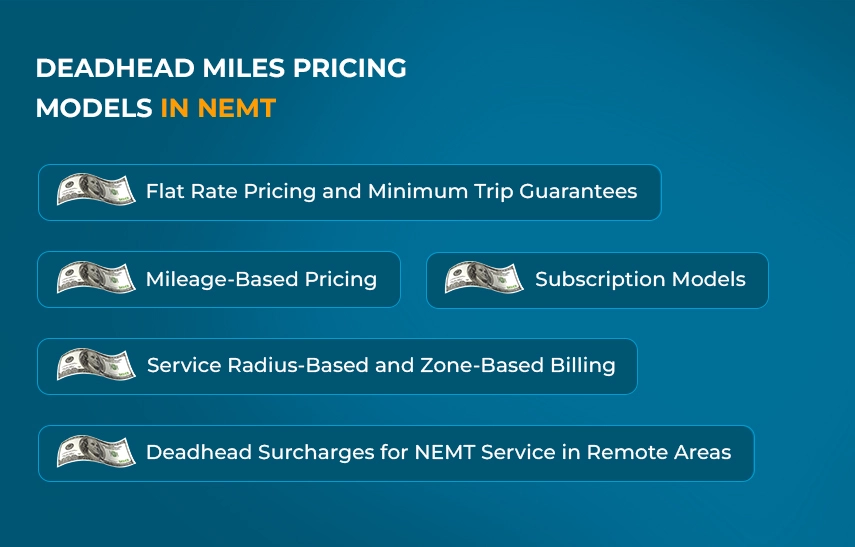Crushing Deadhead Miles in NEMT: Smart Strategies to Charge for or Avoid Them

Non-Emergency Medical Transportation (NEMT) businesses have to constantly fine-tune their operations to boost profitability. This often comes down to managing the smallest details. One of the most significant yet frequently overlooked factors is unloaded, aka deadhead miles. These are “empty”, non-revenue-generating miles driven without a passenger in the vehicle. Whether you're traveling to pick up a client, returning to base after a drop-off, or repositioning between appointments, these miles add up quickly and can silently erode your bottom line.
This article explores practical strategies to set up a clear pricing structure to charge for deadhead miles or minimize them altogether. By tackling this issue, your NEMT business can maintain healthy profit margins without deteriorating the quality of the essential healthcare transportation services.
Contents:
- I. Understanding Deadhead Miles and Their Financial Impact
- II. Industry Standards and Best Practices for Charging Deadhead Miles
- III. NEMT Software Solutions for Managing and Reducing Deadhead Miles
- Conclusion
I. Understanding Deadhead Miles and Their Financial Impact
 Deadhead miles are any miles driven by your NEMT vehicles without passengers on board. These typically fall into three main categories: base-to-pickup, between-trips, and return-to-base miles.
Deadhead miles are any miles driven by your NEMT vehicles without passengers on board. These typically fall into three main categories: base-to-pickup, between-trips, and return-to-base miles.
An industry overview suggests that deadhead mileage can account for 30-40% of total miles driven by NEMT vehicles. The exact number will depend on factors like geographic location (rural places will require longer travel distances), population density, demand fluctuations, and overall efficiency of your operation.
For NEMT providers, this represents a unique challenge when resources like fuel, vehicle wear, and driver time are consumed without generating any revenue. The true cost of these unloaded miles extends beyond just fuel expenses. Providers should also account for the following:
- Vehicle depreciation
- Maintenance costs
- Driver compensation
- Higher insurance expenses
II. Industry Standards and Best Practices for Charging Deadhead Miles
NEMT businesses cannot afford the luxury of absorbing the additional costs associated with deadhead miles. Therefore, several approaches were developed to balance financial sustainability with fair and competitive pricing. Here are some examples of strategies followed by providers to justify and structure their pricing models.
Transparent Communication with Clients and Contract Considerations
Regardless of which billing method you choose, transparency with your private pay passengers and business partners is essential. The transportation provider has to negotiate and clearly explain the deadhead mile policy to clients before service begins. This information should be reflected in service agreements, on your website, and in pre-service consultations. When the reasoning for deadhead miles billing is clearly stated, the clients treat additional costs as a fair business practice rather than an unexpected fee.
Beware. In general, direct Medicaid contracts or brokered trips do not cover deadhead mileage. To get paid extra, facility contracts or broker relationship agreements should specifically address deadhead mile compensation. These are the most common:
Deadhead Miles Pricing Models in NEMT
 Flat Rate Pricing and Minimum Trip Guarantees: In this scenario, the payment for the deadhead miles is incorporated into the pricing. NOTE: The provider risks spending more resources on remote contracts. Therefore, it might be beneficial to negotiate minimum trip guarantees to ensure efficient routing.
Flat Rate Pricing and Minimum Trip Guarantees: In this scenario, the payment for the deadhead miles is incorporated into the pricing. NOTE: The provider risks spending more resources on remote contracts. Therefore, it might be beneficial to negotiate minimum trip guarantees to ensure efficient routing.
Mileage-Based Pricing: The payer has to cover all of the miles covered by the vehicle; in this case, deadhead miles may be priced at a reduced rate.
Service Radius-Based and Zone-Based Billing: The NEMT company establishes a service radius around the base of operations. Within the radius close to the base, deadhead can be absorbed as a part of standard operating costs. However, outside of this “home zone,” additional charges apply for the empty miles traveled. Additionally, this payment structure can be tiered by zones: the farther the zone from the base, the higher the rate.
Deadhead Surcharges for NEMT Service in Remote Areas: Clients located far outside the standard service area may incur a dedicated deadhead surcharge to cover the cost of empty travel.
Subscription Models: Offering subscription-based plans where clients are billed a monthly fee for unlimited NEMT services can mitigate concerns about individual trip costs that may include unloaded distances.
Remember that while it's important to recover deadhead costs, pricing must remain competitive. Analyze your market carefully to ensure your rates account for deadhead miles without pricing you out of the market.
III. NEMT Software Solutions for Managing and Reducing Deadhead Miles
Unfortunately, charging for deadhead miles might not always be possible, so in this case reducing them altogether is even more beneficial. Modern technology offers powerful tools to minimize unloaded miles through better routing, scheduling, and operational efficiency.
Here are some capabilities that a high-performing NEMT software solution brings to the table.
Smart Deadhead Tracking & Analytics
Before tackling the problem of deadhead miles, you need to possess enough data to make informative decisions. The robust NEMT platform automatically distinguishes between loaded and unloaded miles, giving you real-time visibility into how much of your fleet’s activity generates revenue. Over time enough data can be collected to make a deep dive into NEMT analytics and leverage the findings to optimize for inefficiencies.
Intelligent Scheduling & Optimization
Advanced NEMT software leverages sophisticated algorithms to optimize scheduling and dispatching from the start—matching trip requests with the most strategically located vehicles. This minimizes the time and distance vehicles travel empty.
Real-Time GPS and Routing Technology
Deadhead miles can be referred not only to the “empty” distance but to time as well. Being stuck in traffic for hours, trying to get to the pickup location, harms the bottom line just the same. The use of GPS and live traffic data allows dynamic adjustment of routes in real-time. The software also helps to respond to delays, cancellations, or last-minute bookings by instantly rerouting vehicles to ensure the most efficient use of time and fuel.
Zone-Based Dispatching
In large or rural service areas, the software can follow the zone-based dispatching scenarios, assigning vehicles to operate primarily within predefined geographic zones. This can prevent drivers from being assigned potentially unprofitable long-distance deadhead trips.
Multi-Passenger Routing
One more way to increase the productivity of your fleet is through maximizing occupancy and minimizing the number of trips that cover the same route. If the vehicle permits and passengers’ schedules match, the software can combine compatible trip requests for a multi-passenger trip.
Collaborative Partnerships
The NEMT software provides you with the tools to track and efficiently manage your fleet. This precise control also opens up an opportunity to collaborate with other NEMT companies to reduce each other's deadhead miles. You can easily share info about the service, and when advantageous for both companies, exchange trips or do hand-offs between the zones of operation.
Staff Training and Incentives
Regardless of the data transparency and convenience offered by the NEMT platform, it is still up to your team to minimize deadhead miles or eliminate them once and for all. Consider tracking your deadhead percentage (deadhead miles ÷ total miles) as one of the key performance indicators. Train dispatchers to recognize and minimize deadhead situations. Educate drivers about the financial impact of empty miles and implement incentive programs for all parties involved for focusing on efficient routing techniques and reducing deadhead miles.
Conclusion
Deadhead miles represent both a challenge and an opportunity for NEMT providers. While these empty miles create significant costs, they can be effectively managed through a combination of appropriate billing practices and strategic reduction efforts.
Remember that through using an NEMT platform like RouteGenie, you will achieve significant efficiency improvements that compound over time. Even if you manage to reduce deadhead miles by 5%, across an entire fleet over a year of operations, it can represent tens of thousands of dollars in improved profitability. Start implementing these strategies today, and your NEMT business will be on the road to greater financial sustainability and growth.
About the author

Serhii Taborovskyi is the creator and author of the Automotive Territory YouTube Channel, with 300,000 subscribers and counting. He is an avid automotive enthusiast and a fan of any and all motorized vehicles. Serhii is a visiting author at RouteGenie, sharing his expertise for the benefit of the NEMT community.
The author assumes no responsibility or liability for any errors or omissions in the content of this site. The information contained in this site is provided on an "as is" basis with no guarantees of completeness, accuracy, usefulness or timeliness.